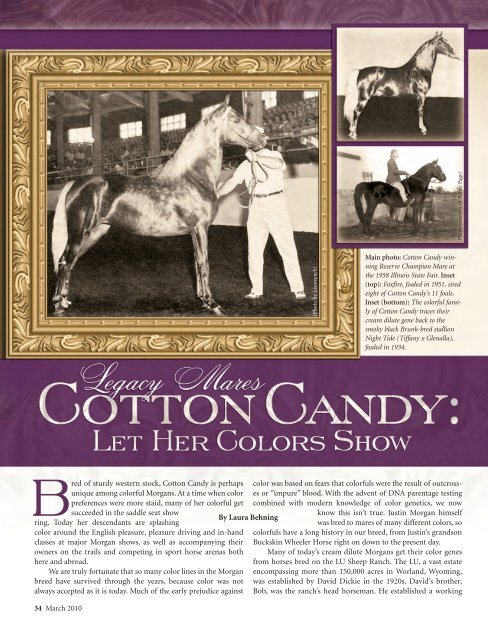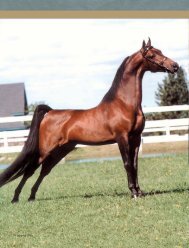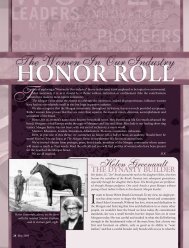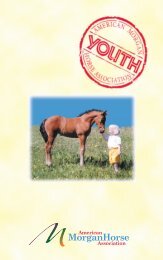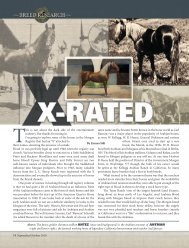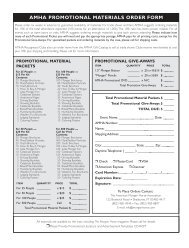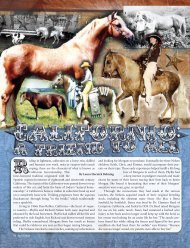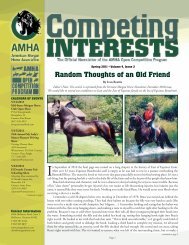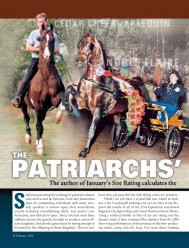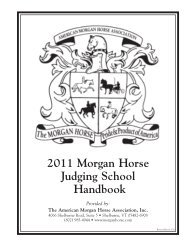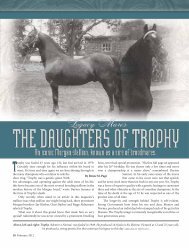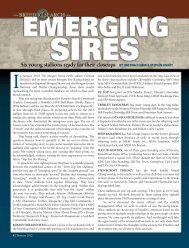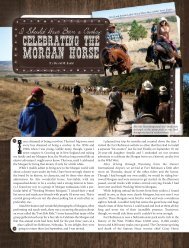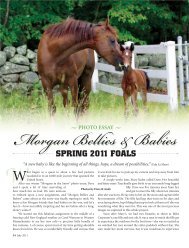LegacyMares CottonCandy 3.10 - American Morgan Horse ...
LegacyMares CottonCandy 3.10 - American Morgan Horse ...
LegacyMares CottonCandy 3.10 - American Morgan Horse ...
- No tags were found...
Create successful ePaper yourself
Turn your PDF publications into a flip-book with our unique Google optimized e-Paper software.
(Photo courtesy of Renee Page)(Photo by Launspach)Main photo: Cotton Candy winningReserve Champion Mare atthe 1958 Illinois State Fair. Inset(top): Foxfire, foaled in 1951, siredeight of Cotton Candy’s 11 foals.Inset (bottom): The colorful familyof Cotton Candy traces theircream dilute gene back to thesmoky black Brunk-bred stallionNight Tide (Tiffany x Glenalla),foaled in 1934.Bred of sturdy western stock, Cotton Candy is perhapsunique among colorful <strong>Morgan</strong>s. At a time when colorpreferences were more staid, many of her colorful getsucceeded in the saddle seat showring. Today her descendants are splashingcolor around the English pleasure, pleasure driving and in-handclasses at major <strong>Morgan</strong> shows, as well as accompanying theirowners on the trails and competing in sport horse arenas bothhere and abroad.We are truly fortunate that so many color lines in the <strong>Morgan</strong>breed have survived through the years, because color was notalways accepted as it is today. Much of the early prejudice against34 March 2010By Laura Behningcolor was based on fears that colorfuls were the result of outcrossesor “impure” blood. With the advent of DNA parentage testingcombined with modern knowledge of color genetics, we nowknow this isn’t true. Justin <strong>Morgan</strong> himselfwas bred to mares of many different colors, socolorfuls have a long history in our breed, from Justin’s grandsonBuckskin Wheeler <strong>Horse</strong> right on down to the present day.Many of today’s cream dilute <strong>Morgan</strong>s get their color genesfrom horses bred on the LU Sheep Ranch. The LU, a vast estateencompassing more than 150,000 acres in Worland, Wyoming,was established by David Dickie in the 1920s. David’s brother,Bob, was the ranch’s head horseman. He established a working
COTTON CANDY, THE DAMTop left: Evenmist Phoenix (Evenmist Topfire x Cotton Candy), 1976 palomino gelding,with Sally Hajek at the Civil War Days event at Lake County Museum, Wauconda, IL;Bottom left and middle: Foxy’s Cotton Queen (Foxfire x Cotton Candy) and Lois Magisanoin 1972. Foxy’s Cotton Queen with Lois Magisano on a trail ride around the property atMirror Lake Farm; Far right (top and bottom): Evenmist MagicMoment with Judy Nason,up. Evenmist MagicMoment with Melanie Bailey at Connecticut <strong>Morgan</strong> in 1990.relationship with the great breeder Helen Brunk Greenwalt, andhorses were exchanged between the two programs. Over the next40-odd years the LU produced more than 550 registered <strong>Morgan</strong>swhich were some of the finest working ranch and show stock oftheir day. Many knowledgeable breeders, to this day, value LUblood in a pedigree for its qualities of soundness, good dispositionand bone.The LU used the Brunk-bred stallion Night Tide (Tiffany xGlenalla) until his untimely death in 1944 at the age of ten. NightTide, registered as black, may have actually been a smoky black,which is a black horse that carries a cream gene. Cream is a dilutiongene that is incompletely dominant, meaning there is moreof an effect when there are two copies of the gene present(homozygous). The heterozygous cream dilutions includepalomino (one cream gene on chestnut), buckskin (one creamgene on bay or brown), and smoky black (one cream gene onblack). When one copy of the cream dilution gene is present on ablack horse, it has no outwardly visual effect (though some ofthem can be more chocolate colored than truly black). Thehomozygous cream dilutions are cremello (two cream genes on?chestnut), perlino (two cream genes on bay or brown) and smokycream (two cream genes on black).36 March 2010What makes us think Night Tide may have been a smokyblack? Several of our modern day cream dilute bloodlines originatefrom four colorful daughters of Night Tide, all foaled in 1939.They include Carmel Snow (palomino, comes down to us throughPineland breeding); Dawnglo (palomino, found in Californio, SanWillidust, and Tio Lalo descendants); Luellen (smoky black, foundin horses of <strong>Morgan</strong> Gold, Nugget Hanneman, and Rusty Walkerbreeding); and the buckskin (registered as dun) mare Luxury, whois found behind descendants of Dickie’s Pride, Desert Sands,Yellow Bird, and Cotton Candy.Cotton Candy (Townshend Gaymeade x Arvada, out ofLuxury), foaled in 1956, was bred by the LU. Registered as a chestnut,she appears palomino in the well-known photo of her as atwo-year-old. She inherited her cream gene from her dam Arvada,who was actually registered palomino. Many of the LU horseswere registered correctly as palomino despite this being an unpopulardesignation in those days. Arvada most likely received hercolor through her dam Luxury who was sired by Night Tide.Cotton Candy was a successful show mare as a youngster, includingfirst place in two-year-old mares and Reserve ChampionMare—to the great Jenny Lake—at the Illinois State Fair in 1958.Judy Nason remembers Candy as “a very kind mare, a great moth-Photos this page by Bob Moseder, Kris Breyer and courtesy of Lois Magisano
er, yet quite hot. I only knew her in her senioryears after she had lost an eye, and wasquite bothered with heaves. I could see andfeel the spirit in her though. Judy Whitneyhad told me once that she was a very hothorse to ride.”Cotton Candy’s descendants comedown to us in a unique way, as none of thepeople who owned her or her offspringwere actively breeding for color. In fact,many of these <strong>Morgan</strong>s, like Cotton Candyherself, were registered as non-colorful.Since <strong>Morgan</strong>s from this family often rantowards the darker end of the spectrum ofcream dilutes—palominos so dark theyappeared chestnut or flaxen chestnut, andbuckskins so dark they could be mistakenfor brown or dark bay—this is understandable.It does make tracking down colorfulsof this family more difficult, unless one hasseen the horses in the flesh or at least goodphotos of them, to discover that they wereactually cream dilutes. Of Cotton Candy’s11 foals, one in particular—a palomino—would leave her mark on future generationsof colorfuls who would also follow intheir ancestor’s show ring hoofprints.The Beginning of aColorful Dynasty:Foxy’s Cotton QueenIn 1969, Lois and Jim Magisano establishedMirror Lake Farm just outside of38 March 2010Cleveland, Ohio, and began breeding<strong>Morgan</strong>s under their Aquila’s prefix. TheMagisanos spent many hours researchingbloodlines, and learned that Foxfiredaughters were highly prized as broodmares.Lois was attracted to the flaxencolor of Foxfire and his offspring, so thecouple set about adding this blood to theirgrowing herd of <strong>Morgan</strong>s. Their firstattempt to purchase a Foxfire daughter ata sale was unsuccessful, so the Magisanosvisited the farm of Paul Rumbaugh,Foxfire’s owner. There they were shown apale-colored filly by Foxfire and out ofCotton Candy (who Lois recalls as “a typeymare, attractive even in her still-sheddingwinter coat”). Though they were unsureabout the filly’s color, as it was not whatthey had in mind, Mr. Rumbaugh assuredthem that she would indeed be a flaxen,just as her full sisters Foxy’s Candy Queenand Foxy’s Candy Doll had been. So thecouple purchased the filly, who theynamed Foxy’s Cotton Queen. They alsoadded Fire Belle, Foxy Fantasia and Foxy’sMusic Girl, all Foxfire daughters, to theirherd. With these four mares the foundationof the Aquila breeding program wassolidly in place.Foxy’s Cotton Queen became a successfulshow mare, a particularly notableachievement given that she was shown byher amateur owners, who did all their owntraining. Her color did not seem to hamperher either; in fact, it might have helped! Atthe Ohio <strong>Morgan</strong> <strong>Horse</strong> Association’s FallShow (now called the Buckeye <strong>Morgan</strong>Challenge) Queen was Junior and OpenEnglish Pleasure Champion. Lois recallsthat there were 23 horses in Queen’s preliminaryOpen English Pleasure class atthat show. “She had a road trot that wasunbeatable and of course, the judge had notrouble picking her out in the large classesat that show. Queen was a great mare forus. She was safe for anyone to ride and hadproven to be successful in the show ring.She produced many outstanding foals forus. I just loved that mare!”But Foxy’s Cotton Queen was not theflaxen chestnut Lois had hoped for, thoughthe Magisanos weren’t certain what colorshe really was at first. When Queen beganproducing colorful foals, the couple realizedthey had a palomino. Color was notpopular at the time and the Magisanos didnot particularly want it. But they got it anyway! Lois says a lot of breeders felt thepalomino line came from Foxfire. She didn’tagree, as the only colorfuls their programever produced came from Foxy’sCotton Queen. This is correct since Foxfirewas flaxen chestnut, not palomino. CottonQueen’s cream gene came from her dam,Cotton Candy, straight down the generationsfrom the LU Sheep Ranch and thestallion Night Tide.Descendants ofFoxy’s Cotton QueenFoxy’s Cotton Queen produced many finefoals—eleven in all— seven mares, twogeldings, and two stallions. None of hercolorful foals were originally registered astheir proper cream dilute color. Queen’s1975 daughter, Aquila’s Night Lace (by theKingston son Applevale Nightwatch), wasregistered chestnut although in fact was avery dark palomino. This mare was thedam of Lacy Lady Lee (by Aquila’s RoyalLea) in 1982, who was also a palomino andone of the very few from her family whowas actually registered as such. Night Lacewas also the dam of Aquila’s Dream Maker(by Aquila’s Royal Lea), a beautiful dappledpalomino (registered as chestnut) geldingowned and loved by Nancy Paschall.
The 1976 stallion Aquila’s Night Pride (ApplevaleNightwatch x Foxy’s Cotton Queen) was registered as abrown but was a brown-based buckskin or a smoky black, ashe sired a palomino stallion, Audron Pal, from the black mareSprite Hawk. This was quite a surprise to his owner RonaldBrietkrenz, who thought he had two black horses!Queen’s 1979 foal Aquila’s Night Delight, also byApplevale Nightwatch, was registered as a bay, but manythought her a buckskin. Lois showed this mare extensivelywhen she was a junior horse and the Magisano’s daughterGina showed her extensively in the junior exhibitor divisionlater. Lois recalls with a chuckle,“She always elicited the question‘What color is she?’ where ever she went. Tom Butler, whowas helping me train at that time, called her ‘...one of thoseorange-bay horses.’ ”Foxy’s Cotton Queen’s 1983 filly was a palomino, Aquila’sQueen Bee (by Paramount Nominee). She also was thought tobe a flaxen chestnut and registered as such. She produced asmoky black—Amandarose—and three buckskins—Aquila’sCrossfire, Valdirose, and Aquila’s Miss Bee Haven. Aquila’sMiss Bee Haven (by Futurity Command), foaled in 1992, avery dark buckskin mare, was thought to be bay and registeredas such. “Bee” would write a whole chapter of her own as shebecame the foundation of breeder Anne Wyland’s colorfulprogram at Ancan <strong>Morgan</strong>s in Davison, MI.COTTON CANDY, THE GRANDDAMLeft: The late Aquila’s TopCommand (FuturityCommand x Foxy’s CottonQueen) survived two colicsurgeries to sire 22 offspring;Bottom: Aquila’s GrandPrize (Aquila’s Grand Slamx Foxy’s Cotton Queen),palomino mare foaled in1987, was a successful parkshow horse. Owned byMirror Lake Farm;Top photo by Suzy Lucine,right photo courtesy of Lois MagisanoThe <strong>Morgan</strong> <strong>Horse</strong> 39
COTTON CANDY, THE GRANDDAMTwo offspring of EvenmistMagicMoment show thathe threw his “honey” color:(top) Spencer For Hire(x Lyonhil Quiet Brass)and (bottom) SimplyMagic (x Carlyle LaMae).(Photo by Dodo Knight)Anne did not set out to breed colorfuls. As with manythings in life, it just sort of happened. She and her husbandRob were attending a <strong>Morgan</strong> sale in the fall of 1996. Anneremembers, “as I browsed the numerous beautiful <strong>Morgan</strong>sthere, I was excited to find Aquila’s Miss Bee Haven in oneof the stalls. Her big expressive eyes and beautiful faceappealed to me. I liked her bloodlines. Her unique coloringmade my heart skip a beat! Her catalog information statedshe was a ‘bay,’ yet she sure looked like a dark golden buckskinto me. My husband bought her for me even though shesold for more than we had agreed to spend. I was thrilled! Iwas uneducated about the color genes and how theyworked, and I didn’t really care. All I cared about was that Inow had perhaps the only pleasure/park buckskin in thebreed. Bee was beautiful, athletically talented, show-bred,and she was all mine.”Bee has produced nine foals for Ancan, seven of whichare palomino or buckskin. Some have been western pleasurechampions, some are pleasure driving champions, and severalhave in hand titles. Not only have they excelled in showrings across the nation, but they are also fun, safe, and reliabletrail horses. From Anne’s late stallion, Fiddler’s Blackriver,crossed with Bee came eight full siblings, all but one of whichwas colorful. This “golden cross” (literally!) created the colorfulbreeding horses present in Anne’s program today, includ-40 March 2010
ing the palomino mare Ancan Destined To Bee, buckskinmare Ancan UnBeelievable, and the farm’s head stallionAncan True Colors, a palomino. Ancan True Colors, or“Blitz” as he is fondly known, is a champion in hand andpleasure driving horse. He is also regularly trail ridden withmares. Year after year he produces colorful foals with classic<strong>Morgan</strong> type, easy-to-work-with dispositions and peopleorientedattitudes. Blitz is the sire of the very first palominoto show in hand at the Grand National and WorldChampionships in 2009, Ancan Color Scheme, owned byBruce and Jean Beckman of Mountain Aspen <strong>Morgan</strong>s inColorado. Color Scheme made quite a splash at Nationals,showing that there are indeed colorful <strong>Morgan</strong>s worthy ofcompeting against the world’s best.Anne says “I am beyond grateful to have theseunplanned fantasy <strong>Morgan</strong>s of color carrying my prefix.They turn heads and hush crowds everywhere they go andthere isn’t a better feeling in the world than having such anenormous crowd of admirers, of all ages, across the UnitedStates and Europe, too.”Yes, Europe—there are descendants of Cotton Candyoverseas, too! Anne and Scott Mayden of Expat <strong>Morgan</strong>s inBelgium have imported several <strong>Morgan</strong>s from Ancan, includingtheir young stallions Ancan Kodachrome (Ancan TrueColors x Nocturnal Melody), a palomino, and Expat’sCOTTON CANDY, THE GRANDDAMThe matriarch of the colorful breeding program at Ancan <strong>Morgan</strong>sis the dark buckskin mare Aquila’s Miss Bee Haven (Futurity Command xAquila’s Queen Bee). Photo by Anne Wyland.The <strong>Morgan</strong> <strong>Horse</strong> 41
COTTON CANDY, FURTHER GENERATIONSRight: Aquila’s Dreammaker(Aquila’s Royal Lea x Aquila’s NightLace). You can see why we might registerthese foals as chestnuts ratherthan palominos, when you look, notonly at him as a foal, but at hisdam’s color. Bottom: MLB TheMadame (Aquila’s Top Command xBoogie Wild) with Mary Brannon ina pleasure driving class at Mid A.(Photo by Shane Shiflet)Regimental Colors (Ancan True Colors x RHB Gemini), abuckskin. Both are headed towards careers as sport horses.Foxy’s Cotton Queen’s 1987 foal was Aquila’s GrandPrize (by Aquila’s Grand Slam), a palomino mare who wonnumerous park saddle classes throughout the Mid-West. Shecommanded the judges’ attention, and this in a day when colorfulhorses were not very popular, especially in the showring. Prize retired to the broodmare band when an unfortunatefracture of a small bone in her foot ended her showingcareer. Her colorful offspring include the buckskin mareAquila’s Grand Vanessa (by Futurity Command), the palominogelding PL Good As Gold (by K-Wood’s Golden Eagle),and Aquila’s Sure Prize (by Futurity Command), a buckskinmare. Sure Prize has in turn produced three foals—all colorful—includingLaurie Faust’s successful show stallion MLBCapo di’ Capo (by The Last Don), a buckskin, and SkylandEpiphany (by Fiddler’s Blackriver), a buckskin broodmare forShades of <strong>Morgan</strong>s in NY.Rounding out Foxy’s Cotton Queen’s colorful producingoffspring is her last foal, the late Aquila’s Top Command(by Futurity Command). Foaled in 1988, the palomino stallionbecame a part of breeder Laurie Faust’s life in 1999.Laurie remembers “I had spent the better part of four yearson a quest trying to locate the type of colorful that also carriedthe bloodlines I desired. A beautiful, refined, long42 March 2010
necked, big eyed, beauty with the bloodlines that includedWaseeka’s In Command, Nocturne, Upwey Ben Don,Senator Graham and Flyhawk to name a few.” One day shewas stunned to see an ad for Aquila’s Top Command in herFlorida <strong>Morgan</strong> <strong>Horse</strong> Association’s membership directory.Coincidently, the ad was located just above her farm listing.“Topper” was exactly what Laurie was looking for—and hewas right there in her home state! “I immediately arrangedto visit the farm where the stallion was standing and waseven more impressed with him in person,” Laurie says.Unfortunately it took another three years and a series of verysad events in this stallion’s life before Laurie’s dream of owninghim became a reality. Laurie continues, “In September1999 Aquila’s Top Command was purchased. Topper hadalready suffered through two colic surgeries in the 24months prior to our purchase, and was extremely debilitated.”The strong spirit of the stallion, combined with Laurie’sTLC, pulled him through.In his lifetime Topper sired 22 foals, 14 of which werecolorfuls. Laurie has one of his palomino daughters, thebeautiful and typy Glyndan Melodious Joy (x Arista’s SnappyTune) in her current broodmare band. Topper’s most successfulshow horse offspring was the Pleasure Driving and inhand star, MLB The Madame (out of Boogie Wild). Sadly,Laurie lost this incredible mare last fall.(Photo courtesy of Anne Wyland)COTTON CANDY, FURTHER GENERATIONSTop: The palomino AncanKodachrome (Ancan TrueColors x Nocturnal Melody),one of two Ancan imports headingthe stallion lineup at Expat<strong>Morgan</strong>s in Belgium, is shownhere in a jumping competitionat Welkenraedt, Belgium inOctober of 2009; Middle: It hasbeen rare to see colorful<strong>Morgan</strong>s showing in-hand atthe Grand National level. Lastyear the Beckman’s Ancan ColorScheme helped to break thisbarrier, in Grand NationalYearling Stallions handled byBob Kellert; Bottom: Shownhere after winning ChampionPleasure Driving horse at theMJMHA Showtime <strong>Horse</strong> Showin 2005, the palomino stallionAncan True Colors (Fiddler’sBlackriver x Aquila’s Miss BeeHaven) does triple duty as abreeding and trail horse for hisowner/breeder Anne Wyland.The <strong>Morgan</strong> <strong>Horse</strong> 43
Topper also has offspring that are producingcolor for other owners, such asBelfair Krugerrand, a palomino stallion(out of Belfair Scarlet Ride), proudlyowned by Alene Evans in Washington. Hein turn has sired several colorful offspring.Other Branches ofThe Cotton CandyFamily TreeCotton Candy’s 1976 foal was the palomino(registered chestnut) gelding, EvenmistPhoenix (by Evenmist Topfire). At age 10Phoenix was acquired by Sally Hajek forthe price of his unpaid board bill. Phoenixand Sally participated in a number ofparades (often as the riderless horse forVeterans parades), reenactments, competitivetrail rides, pleasure rides and historicaldisplays. He was true to his show horseancestors, too. Kris Breyer, who boardedPhoenix for Sally, says “He loved to parkwalk down the streets in parades.”While Foxy’s Candy Queen was themost prolific colorful daughter of <strong>CottonCandy</strong>, the mare also had a buckskin sonwho bred on. Evenmist Magicmoment wasCotton Candy’s final foal, born in 1978.Cotton Candy was then owned by CarlSchmelzer of Concord, NH, for whom sheproduced five foals. Trainer Judy Nasonhad Mr. Schmelzer’s horses at her barn atthe time, and they bred Candy to Carl’shandsome bay stallion, Highover Patriot.The result was “Danny,” who Judy ownedfrom the day he was born. “He was registeredbay, and was what I called a ‘honeybay,’ as he had no dorsal stripe down hisback,” Judy remembers. “He was wellreceived by most judges, despite his color,and was grand champion stallion a numberof times here in New England. Thatsays a lot about his conformation, as theNew Englanders love their bays and chestnuts.He was a great show horse, but hatedthe lesson part of things, so as he got intohis high teens, I placed him with a wonderfulowner and caretaker. She enjoyedevery day with him until his death a fewyears ago.”Danny was, like so many others of hisfamily, a colorful who could pass as a noncolorful. He had 8 foals before being geldedand several of them were the same“honey bay” color of their sire. His 1981buckskin daughter Lady Evenmist (out ofSkyfield Maranda) has produced threefoals including the buckskin stallionLakewind Augustus (by LakewindMaximillian).The Legacy ofCotton CandyThis one little yellow mare from the LU hasmade an indelible impact on today’s colorful<strong>Morgan</strong>. Her influence has even spreadoverseas. Once living in a time when theircolor was considered a liability, todayCotton Candy’s descendants are glitteringgold as the popularity of color continues toincrease. They make up the highly prizedfoundation of several major colorfulbreeding programs, and we will see thatinfluence continue into the future. As AnneWyland says “Cotton Candy definitely putthe ‘sweet’ in my breeding program, and Isalute her for that.” n44 March 2010


